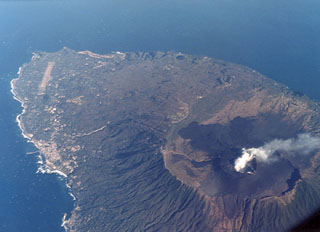Report on Izu-Oshima (Japan) — September 1986
Scientific Event Alert Network Bulletin, vol. 11, no. 9 (September 1986)
Managing Editor: Lindsay McClelland.
Izu-Oshima (Japan) More earthquakes; continued tremor; rumbling
Please cite this report as:
Global Volcanism Program, 1986. Report on Izu-Oshima (Japan) (McClelland, L., ed.). Scientific Event Alert Network Bulletin, 11:9. Smithsonian Institution. https://doi.org/10.5479/si.GVP.SEAN198609-284010
Izu-Oshima
Japan
34.724°N, 139.394°E; summit elev. 746 m
All times are local (unless otherwise noted)
A seismic station ~5 km N of the crater recorded 354 earthquakes in September, a marked increase from 41 in August (table 2). Nine events were felt at the Oshima weather station in September, the largest a M 4.0 shock accompanied by rumbling on 11 September at 2146. Earthquake swarms were recorded 11-13 and 26-27 September, with epicenters on the W and N coasts of the island respectively. Volcanic tremor with maximum amplitude of 0.7-0.8 µm continued throughout the month.
Table 2. Number of local earthquakes recorded by a seismic station about 5 km N of the crater at Oshima, April-September 1986. Courtesy of JMA.
| Month | Earthquakes |
| Apr 1986 | 695 |
| May 1986 | 24 |
| Jun 1986 | 21 |
| Jul 1986 | 10 |
| Aug 1986 | 41 |
| Sep 1986 | 354 |
The previous earthquake swarms were redorded in 1877, 1983, and most recently 16-24 August 1985, when almost 300 events with a maximum magnitude of 2.9 occurred just beyond the NW part of the somma.
Geological Summary. Izu-Oshima volcano in Sagami Bay, east of the Izu Peninsula, is the northernmost of the Izu Islands. The broad, low stratovolcano forms an 11 x 13 km island constructed over the remnants of three older dissected stratovolcanoes. It is capped by a 4-km-wide caldera with a central cone, Miharayama, that has been the site of numerous recorded eruptions datining back to the 7th century CE. More than 40 cones are located within the caldera and along two parallel rift zones trending NNW-SSE. Although it is a dominantly basaltic volcano, strong explosive activity has occurred at intervals of 100-150 years throughout the past few thousand years. A major eruption in 1986 produced spectacular lava fountains up to 1,600 m high and a 16-km-high eruption column; more than 12,000 people were evacuated from the island.
Information Contacts: JMA.

